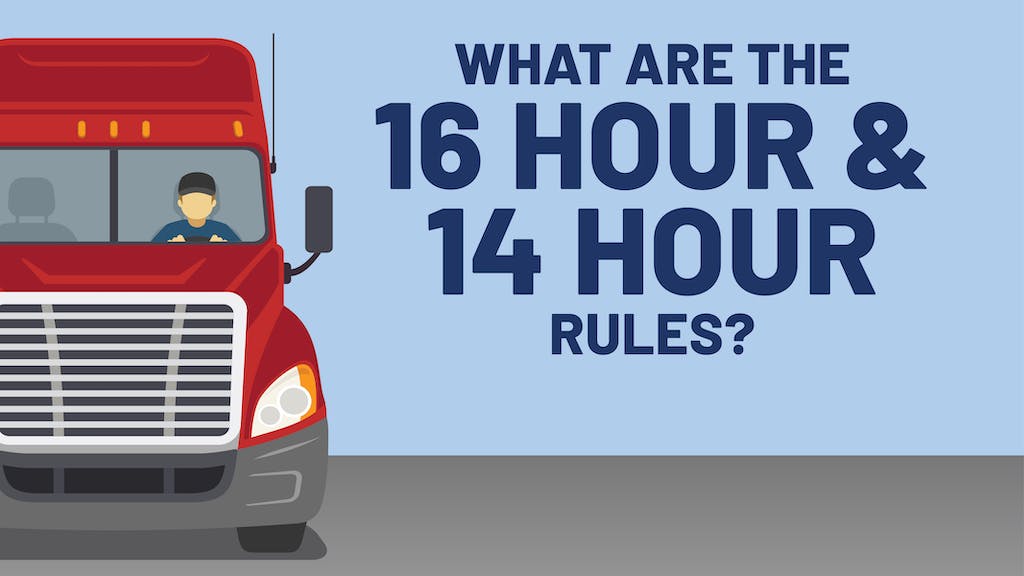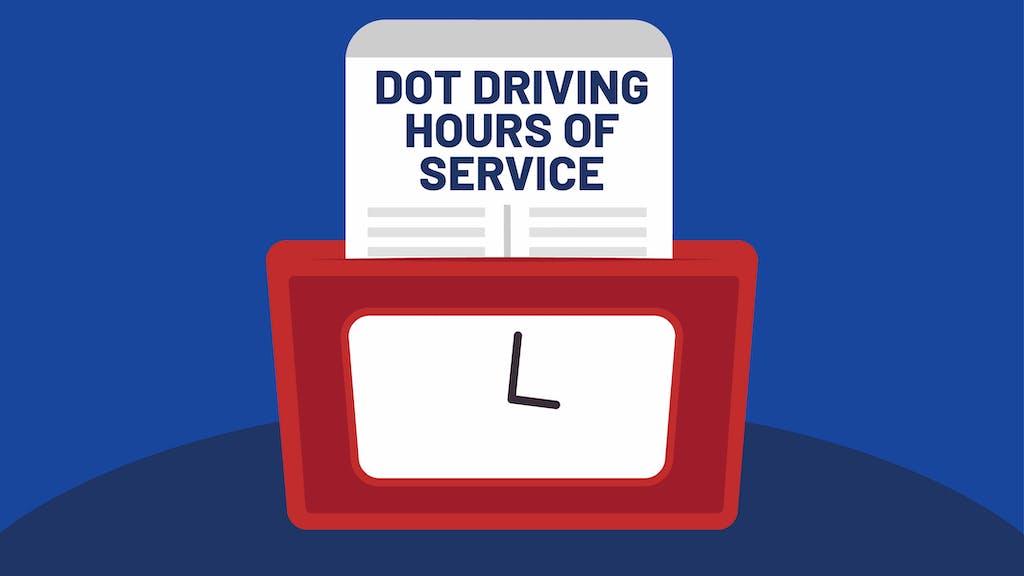DOT Driving Hours – What is the 16 Hour and 14 Hour Rule?
October 14th, 2022

Hours of service (HOS) standards are effective safety compliance procedures established by the United States Department of Transportation (DOT) to ensure drivers are rested, awake, and attentive. Tracking HOS takes up a great portion of time, and it is advised that you record it throughout your journey.
Understanding these rules is critical for both drivers and fleet management. Many carriers are reviewing HOS regulations to better understand the changes and exceptions to the detailed rules for when drivers can be on the road because of the new electronic logging device (ELD) legislation, which is overhauling the methods drivers use to track their record of duty status.
The drive times have various exceptions, and it can be quite useful for drivers whose frequent routes call for special measures to know what to do. Let’s look at the HOS laws, so you understand how to comply with DOT driving hours and other driving regulations.
What is DOT Driving Hours?
The DOT driving hours guidelines outline how many hours commercial truck drivers can drive and work per day and week. These regulations determine the amount of time drivers can spend behind the wheel, with obligatory rest periods to ensure they’re rested before they start a new shift.
Drive-time is assessed very closely by the DOT, imposing penalties on any party that fails to comply with hours of service standards. All interstate drivers who operate a commercial vehicle with a gross vehicle weight rating (from the manufacturer) of more than 10,001 pounds are subject to HOS laws.
What is On Duty Time?
On-duty time accounts for semi-drivers HOS. To calculate on-duty time, take the number of hours worked – or ready to work – by the truck driver. All this time includes what the driver spends time doing, like the following tasks:
- Driving
- Inspection, service, and maintenance of the truck
- Waiting in the queue to be dispatched by the carrier
- Loading or unloading the truck
- Completing shipment paperwork
- Performing repairs
- Taking employment drug and alcohol tests
- Additional tasks for the carrier
On-duty time includes all time spent in the truck, excluding:
- When sitting in a parked car
- While sleeping in a sleeper berth
- When sitting in the passenger seat of a property-carrying vehicle (for up to two hours [according to specific circumstances])
Why Do DOT Driving Hours Exist?
HOS laws are in place to help truck drivers perform better by keeping them well rested and attentive. These laws also protect long-haul drivers and others on the road from potentially catastrophic accidents.
It is vital to keep drivers engaged and ready to go in order to keep the roadways safe. When your organization ensures the entire fleet complies with all FMCSA HOS standards, it promotes driver safety and minimizes total risk.
Who Must Comply With DOT Driving Hours?
HOS applies to all drivers operating a commercial motor vehicle (CMV) in the United States, whether they are domestic or international carriers from Canada or Mexico. A CMV is a vehicle (with or without a trailer) that meets any of the following criteria:
- Any load at least 10,001 lbs
- Gross vehicle weight rating or gross combination weight rating of at least 10,001 lbs
- Transport of hazardous items in quantities that necessitate placards
- Made for or used to transport 16 or more persons, including the driver, without pay
- Made for or used to transport nine or more persons, including the driver, with pay

DOT Driving Hours of Service
Before you get on the road, we want to make sure you’re aware of the HOS rules in detail.
14 Hour DOT Rule
The 14-hour rule indicates that if a property-carrying driver returns to duty after 10 consecutive hours off, they cannot drive for more than 14 hours.
This daily restriction is intended to reduce driver fatigue by limiting the total number of hours a driver can work in a day. It includes driving, rest breaks, and various off-duty periods (i.e., lunch breaks, mandatory rest allowance, etc.). This 14-hour driving window does not change whether the driver goes off-duty for a break or nap.
16 Hour DOT Rule
In relation to the 14-hour rule, the DOT 16-hour rule allows drivers to extend their 14-hour workweek by two hours under certain conditions. This is a special exception, but it does not let a driver to go past the allotted 11 hours of driving per day cadence. The DOT 16-hour rule can be implemented once every 34-hour reset cycle within a work week.
This exception applies to drivers who began and ended their workdays in the same area for the prior five workdays. Because they return to the same job area every day, these drivers are considered short-haul drivers. The driver may stay on duty for an additional two hours under the 16-hour DOT rule but must be relieved of duty immediately after the 16th hour.
Other DOT Driving Restrictions
In addition to these DOT HOS rules, there are other DOT driving restrictions you should know, from DOT tire regulations, to other time-sensitive tasks.
Let’s look at three other DOT driving regulations for over-the-road safety:
- 60-hour/70-hour limits: Truck drivers who do not drive every day of the week are not allowed to drive after 60 hours on duty in seven days. They may not drive after 70 hours on duty in eight consecutive days if they drive every day of the week. In either scenario, the driver may begin the seven- or eight-day period after 34 consecutive hours off duty.
- 34-hour reset: After 34 consecutive hours off duty, truck drivers can resume their 60-hour/70-hour driving limits. After resetting the clock with the time off, they can begin their new work week. During the restart period, the driver may undertake on duty responsibilities other than driving, like paperwork, loading, and unloading cargo.
- 1-hour/10-hour rule: Property-carrying drivers be on the road for up to 11 hours following 10 consecutive hours off duty within a 14-hour period. The restriction for passenger-carrying truck drivers is 10 hours of driving after eight consecutive hours off duty.
The DOT has created these rules to regulate how truckers monitor their work-life balance throughout the normal course of job performance.
Frequently Asked Questions
How is truck driving time calculated?
To calculate truck driving time, a driver takes the number of hours worked – or ready to work – by the truck driver. The time spent on duty includes driving and other necessary tasks.
How many hours a day do truckers drive?
Truckers are not allowed to drive for more than 11 consecutive hours and can only work a 14-hour shift. For example, if their day looks like loading and paperwork for four hours, they can drive for the remaining 10 hours.
What happens if you go over your allotted time?
If a driver is detected exceeding HOS, they may be removed from service until they have spent enough time off duty to be back in compliance. Depending on the gravity of the offense, the driver could face a variety of penalties from local to federal authorities.
Do DOT Rules Vary by State?
Each state has its own version of these restrictions, but some are enforced at the federal level.
While the Federal Motor Carrier Safety Administration (FMCSA) establishes the baseline standards that states must achieve for CDLs and Commercial Learner’s Permits (CLP), the administration of the CDL program and issuance of the license remains the sole responsibility of the state’s.
Stay Current on DOT Laws
Now that you’re ready for the road log your time accordingly, you can check in with our experts at Hale Trailer if you’re unsure how to stay DOT compliant on the road. Familiarize yourself with the regulations so you can keep your work-life balance together when you’re on and off duty.
We have the experience to help you strategize your delivery when choosing the right vehicle and equipment. Our various trailers are ready for any long haul, whether you’re looking to purchase or rent. Browse our line-up online or at one of the trailer rental locations if you want to learn more about how we can work for you.
All the information on this website – https://www.haletrailer.com – is published in good faith and for general information purposes only. Hale Trailer Brake and Wheel does not make any warranties about the completeness, reliability and accuracy of this information. Any action you take upon the information you find on this website, is strictly at your own risk. Hale Trailer Brake and Wheel will not be liable for any losses and/or damages in connection with the use of our website.
